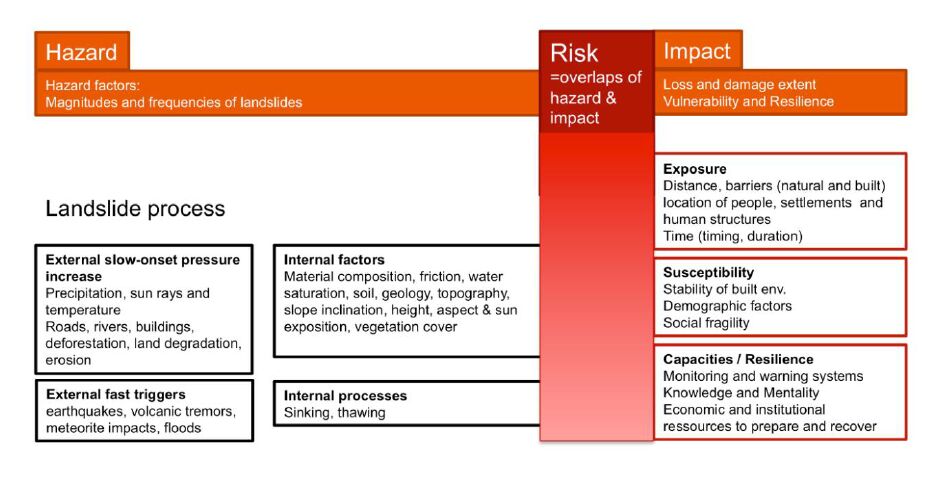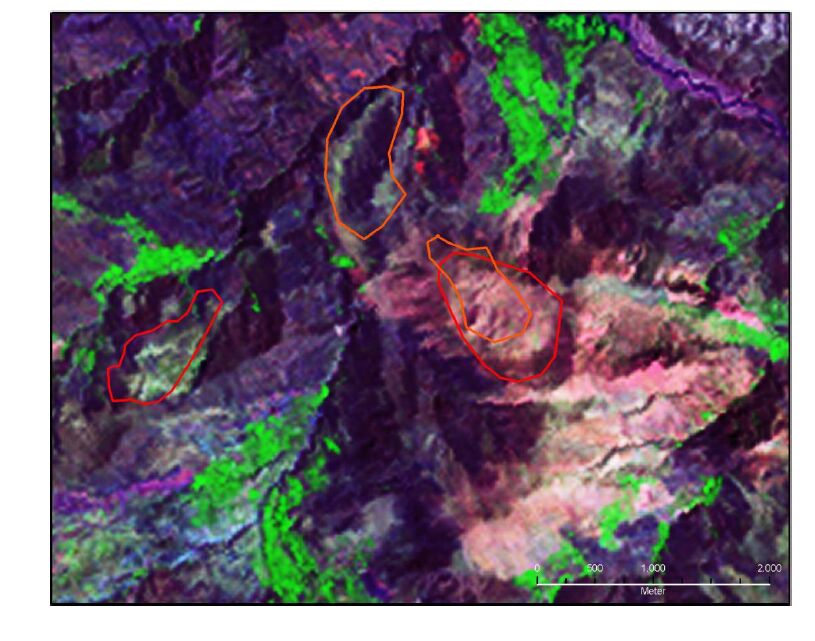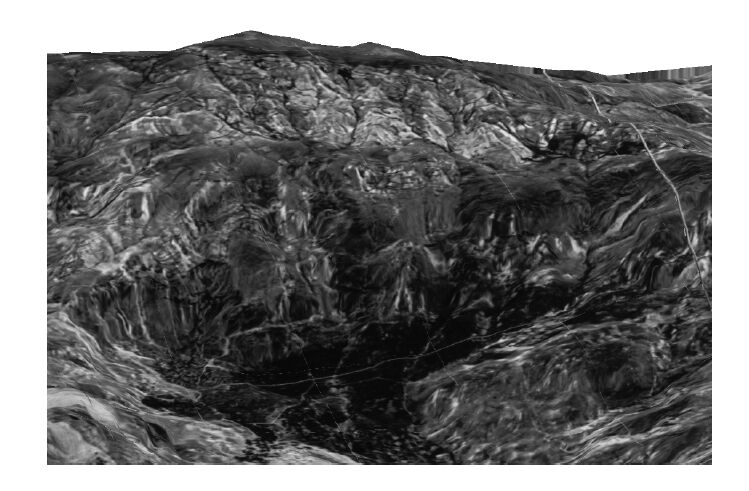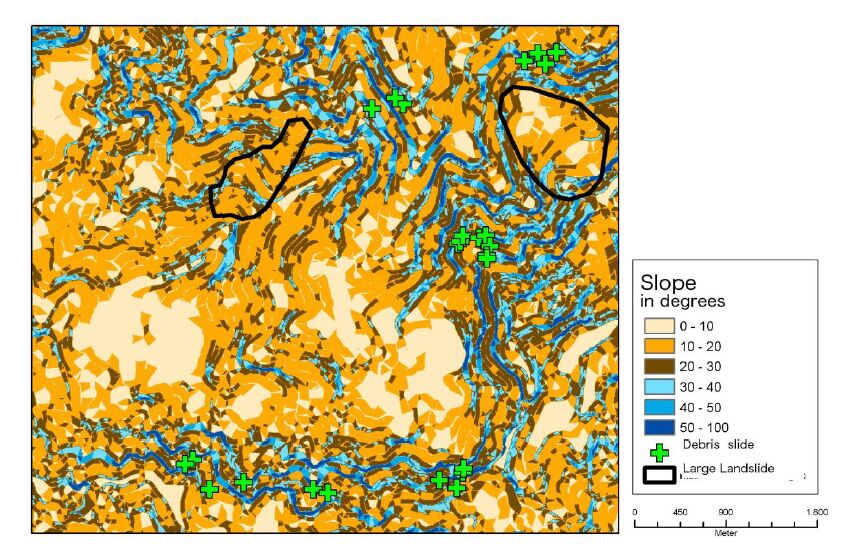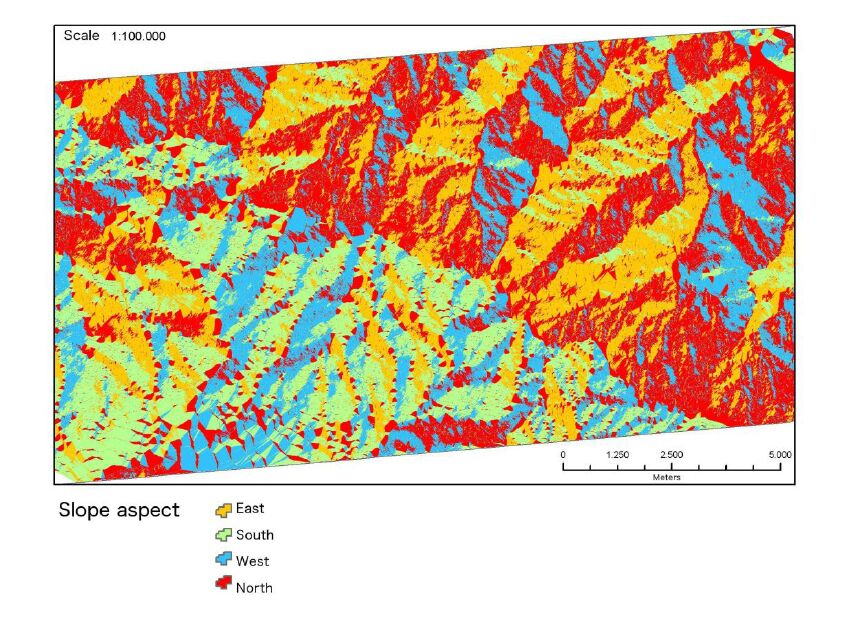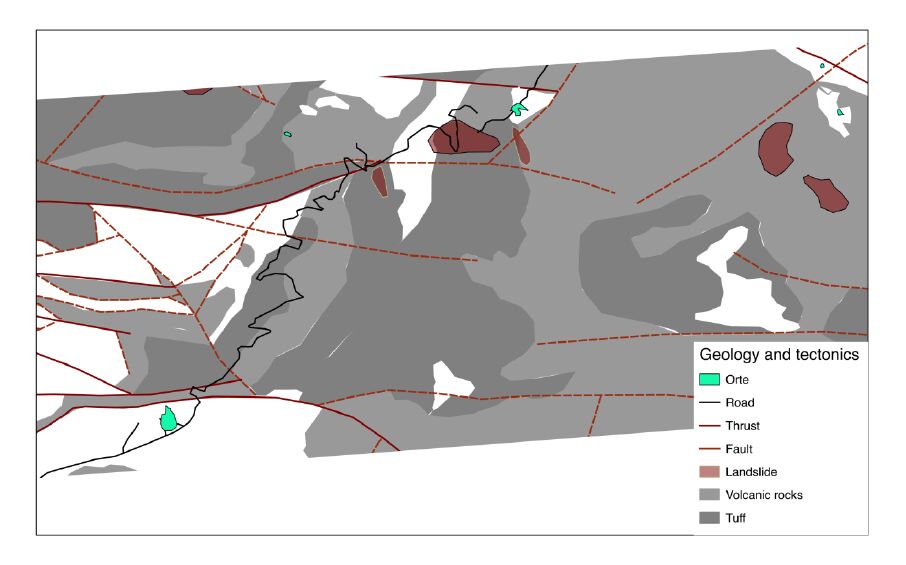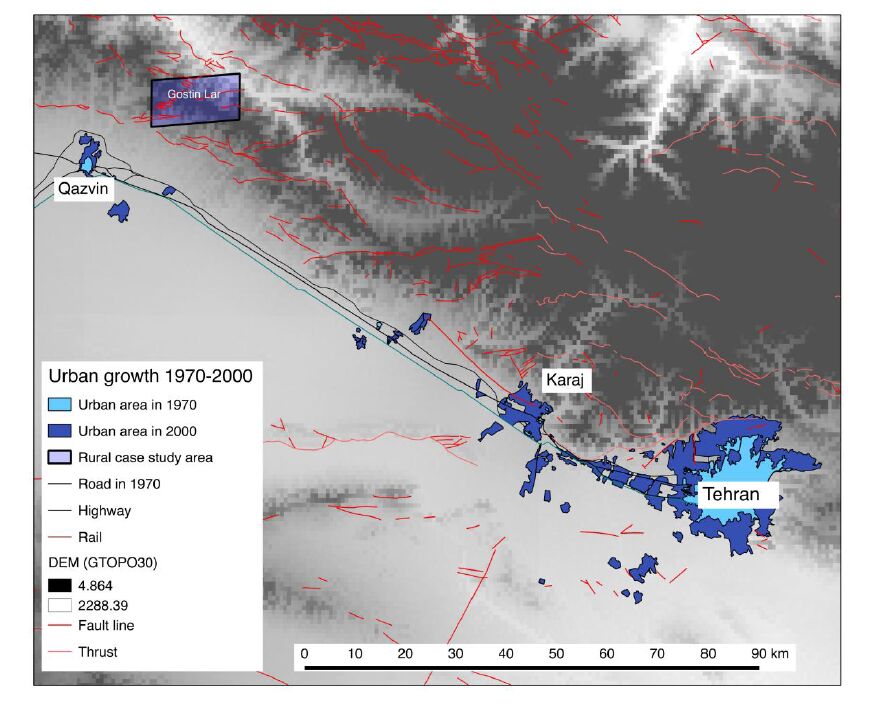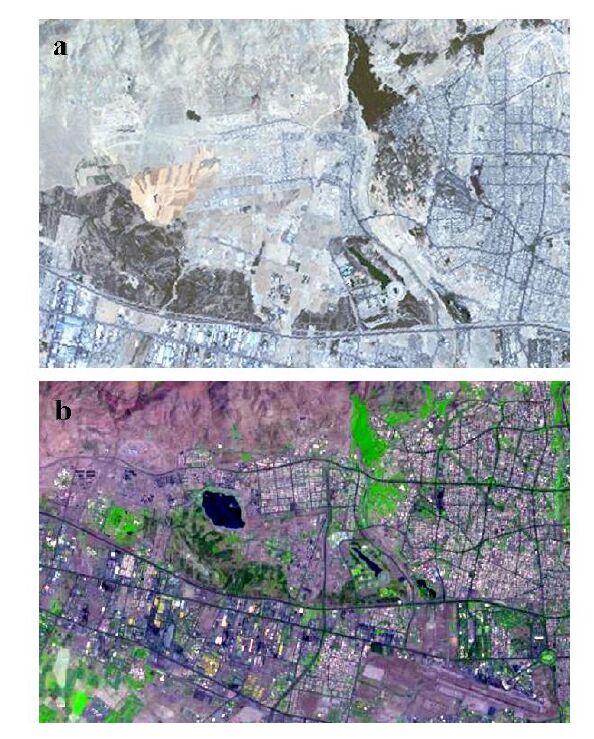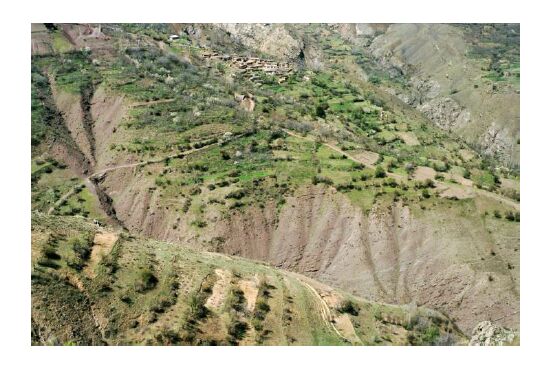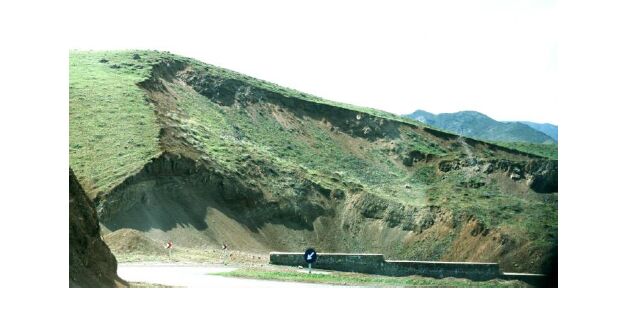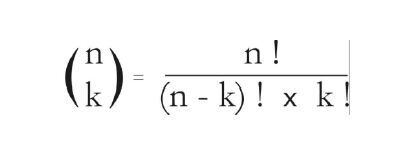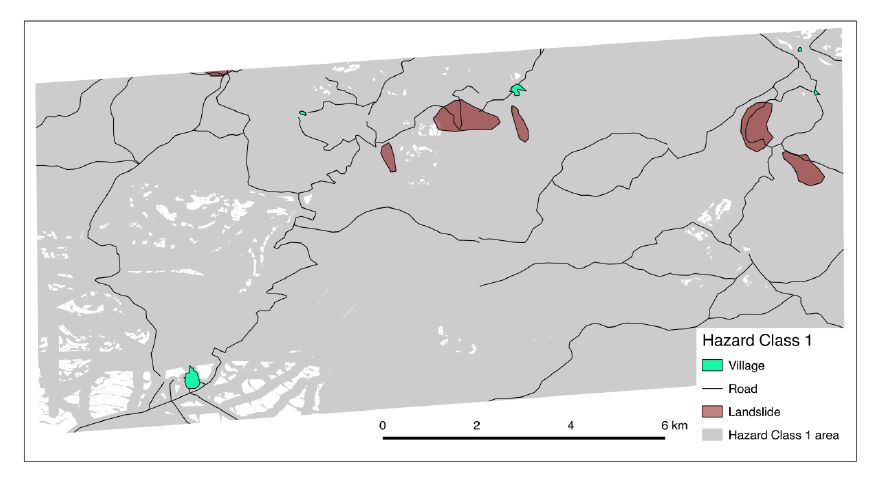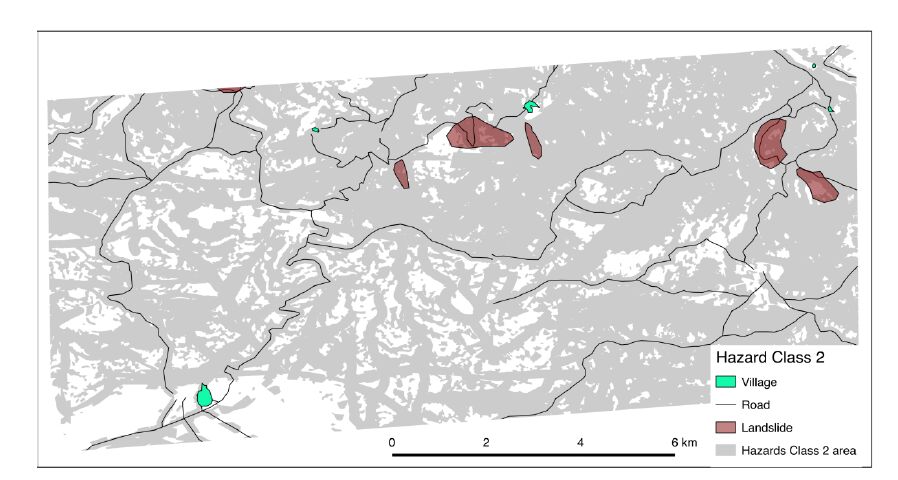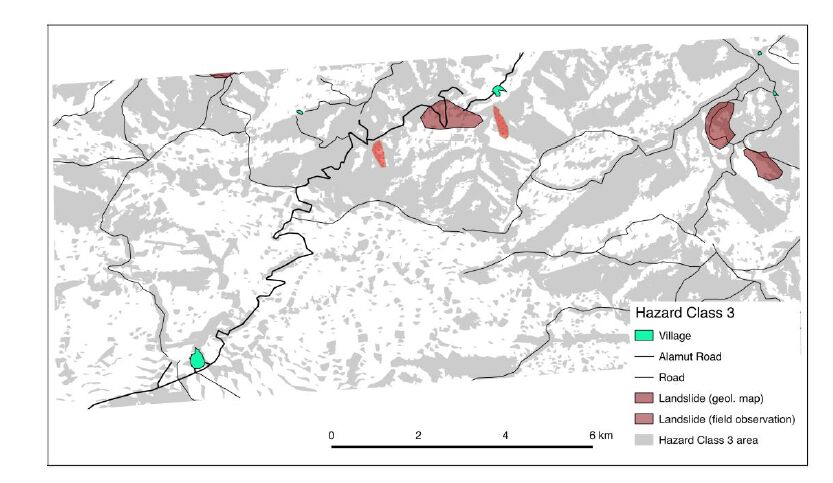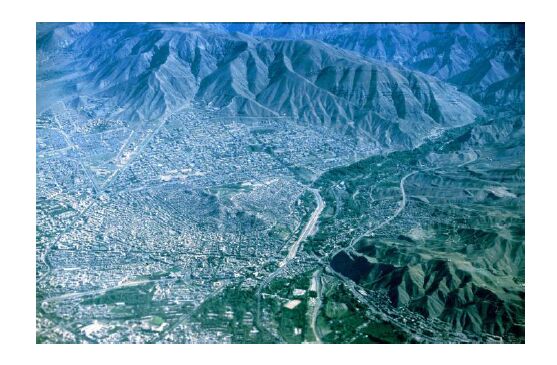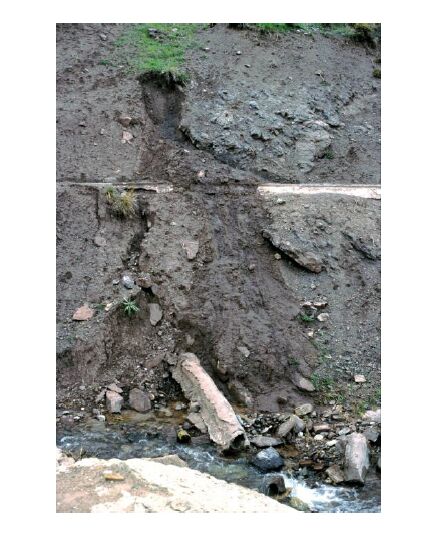1. Introduction
Landslides cause human loss in Iran and worldwide, due to climate, geology, human exposure, land use, topography, urban growth, and triggers such as earthquakes. Landslides occur due to a combination of natural and human factors. Land degradation and settlements built in steep terrain, but also road construction all contribute to landslide occurrence. The main motivation of this study is to investigate how landslides can be detected and how landslide-triggering factors can be identified in a certain area in order to better inform risk assessments. These assessments should lead to a better disaster risk management body of knowledge. This knowledge can then lead to a reduction of lives lost. This paper looks at data from several decades in order to capture changes in landslide occurrence, but also changes in settlement growth.
The western part of the Alborz Mountains in Northern Iran was selected because of historical and recent landslide occurrences, topography, and shallow vegetation cover that allows for remote sensing based imagery monitoring. This area is further characterised by a proximity to earthquakes. The capital city, Tehran and two neighbouring cities spread along a transect separating mountainous from flat area in the plains (Figure 1). The cities of Karaj (population of 1.6 million in 2013, data.un.org 2016) and Quazvin (population of 381,598 in 2013, data.un.org 2016) lie along a main traffic route that leads from Tehran (population of 8.1 million in 2013, data.un.org 2016) to the west, towards the borders of Armenia, Azerbaijan, Iraq and Turkey.
1.1. Gaps and Demand
There are still assessment gaps for areas that are severely affected by natural hazards as is Iran and thus there is a demand for studies that showcase limitations [1]. Apart from the theoretical debate what is hazard, risk, vulnerability and resilience there is still a need to operationalise such concepts, This need includes demonstrating which factors can be captured, highlighting new factors to capture and mapping uncovered areas [2]. This will help to increase risk awareness in such risky zones and also provide researchers baseline data for later comparisons.
Within the remote sensing community, much emphasis lies on technical and methodological advancement of data analysis, related algorithms, ways of classifications and object extraction. Visual interpretation itself is not highly regarded. However, especially for Disaster Risk Management (DRM), such applied and feasible methods are valuable. Knowledge platforms such as UNSPIDER (www.un-spider.org) offer linkages between science and practitioners. International Charter calls for usage of satellite imagery are issued in cases of major disasters such as the Haiti earthquake in 2010. The importance of spatial and satellite information is internationally used and accepted and promoted, for instance within the actions of UNISDR and in the Sendai Framework [1]. However, also at national levels and increasingly, community levels, spatial methods such as Geographic Information Systems (GIS) proliferate and become vital sources for practitioners. Therefore, the main objective of this article is to address the usability of satellite imagery and visual interpretation for DRM.
1.2. State-of-the-Art
Knowledge about slope stability [3], landslide types, processes [4,5,6] hazard zonation [7,8] and landslide inventory mapping at different spatial scales [9,10] is well established [11]. It is available astext-book knowledge for multiple types of landslides, methodologies, factors [12], secondary hazards and regions worldwide [13].
Factors contributing to landslide triggering mechanisms, such as precipitation [14,15] hydrology [16], soil conditions [17], slope and aspect [18], temperature and snow cover [19] can partly be transferred from other regions of the world to the assessment in Iran. Landslide modelling techniques [20], human vulnerability [21], loss and damage [22], for example, on transportation infrastructure [23] and overall landslide risk management [24,25] and combinations of causal factors [26] is well established and approaches can be transferred to and from regions like Iran to a certain degree.
Opportunities provided by satellite data for identifying and monitoring landslides have been tested and documented for different types of landslides and regions [27,28], including Landsat [29]. Digital Elevation Models (DEM) or Digital Terrain Models (DTM) have also been widely used to identify landslide susceptibility factors [30]. Recent deterministic analyses of landslide stability use different remote sensing data such as ASTER, Spot-5, and combine it with DEM and publicly available routing data [31].
Remote sensing applications have become standard textbook knowledge for a large variety of applications and fields, including risks such as wildfires [32]. The applicability of Geographic Information Systems (GIS) to landslide modelling [33,34,35] and zonation is well documented, too [36,37,38]. Overviews on different usages of spatial data and factors to be captured have been summarised [39]. Reflection, problems and critique on the usage of GIS in relation to landslide risk assessment have been brought forward, too [40,41,42].
Landslides are a known problem for Iran. For example, one of the largest landslides world-wide, the Saidmarreh landslide (claimed to be the largest known-to-date) occurred in southwestern Iran [43] and its debris cover about 64 square miles. There has been much recent research carried out on landslide risks in Iran; in different regions and provinces, for example, in Golestan [44], or North East Iran [45,46].
For Tehran, landslide susceptibility mapping has been carried out using GIS [47]. For the neighbouring city in the west, Karaj, interactions between landslides and tectonics have been analysed [48]. In the Alborz Mountains, various landslide factors are analysed using GIS, for instance, in the Safarood Basin [49] or the Haraz watershed in the Mazandaran province [50], in Central Alborz [51] or in several neighbouring provinces [52]. There are several large landslides in this area that partly date back to prehistoric times, and relationships to earthquakes and fault lines are recorded [53]. Close to neighbouring Azerbaijan, landslide factors were mapped using GIS for Bostan Abad county [54]. Landslide process reactivation of a large landslide north-east of Tehran is mapped using GPS and SAR data [55]. Risk factors such as geology, lithology and frequencies of landslides have been analysed for North Iran, Mazandaran [56].
Earthquake mechanisms in the area in Northern Iran have been widely documented [57] as is geology and tectonics of the Alborz Mountains in this area west of Tehran city [58]. Geology has been mapped and discussed for this area [59]. Earthquake risk and landslide risk to the region is well documented, based on historic occurrences and geological knowledge [60,61]. Sheltering and reconstruction after earthquakes has been documented, for instance, for the 2003 Bam earthquake [62].
1.3. Objective and Research Questions
This paper will contribute to the overall research question; how can environmental risks be better identified and understood in order to save lives?
The following auxiliary research questions will help to narrow down this scope with respect to the following selected aspects:
a. Which landslide hazard and exposure factors can be detected by satellite data?
b. Which information layers about the natural and human factors of landslide risk can be obtained from such data?
c. What kind of information can be provided to planners wishing to base decisions on such information?
2. Methods and Material
This paper adopts an established natural hazard and risk concept that differentiates risk into hazard and vulnerability components [63,64,65,66]. However, the main focus in this paper lies on hazard and exposure mapping. Within the hazard model, hazards and hazard events as well as triggering factors can be differentiated (see Figure 2). Utilising a spatial approach [67], geographic information is collected using various sources and integrated within a GIS environment.
Landslide risk is composed of many factors, such as those factors that enable the landslide process itself and those related to damages to people and man-made structures. The factors that cause landslides can be subdivided into internal and external factors. Internal factors can be soil, geology, slop inclination, height, sun exposition, or vegetation cover. External factors for the landslide process are precipitation, sunrays and temperature. There are additional factors that increase the load on the landslide or that might trigger the landslide process, such as earthquakes, floods, volcanic tremors, or, roads and rivers, which destabilise the hill basis. For humans, the risk to be affected by landslides then needs to take into account the exposure to the landslide, typically the location of settlements or human structures in reach of a landslide event run-out. In addition to this, specific features that render the population especially vulnerable to landslide impacts could be added such as susceptibility of buildings; for example, their stability to withstand debris flows [68]. Of course, psychological factors also add to susceptibility as are baseline demographic factors such as age [67]. Old people might possess less physical strength to run from a debris flow, for example. Economic, institutional and other factors would have to be added here, too. The counterpart of susceptibility, sometimes termed coping capacity [64] or resilience [67,69], is also an important field of research. However, in this study, the focus lies mainly on the landslide process and which components can be identified using satellite imagery. Settlement location and expansion dynamics are only added to demonstrate the relevance of landslide and earthquake risk for this research area.
The landslide and earthquake hazard factor detection will be conducted by using secondary data, specifically, earthquake records, geologic maps, precipitation data from climate stations and by visual analytics of satellite imagery, supported by a ground truthing field trip to collect GPS data, soil samples and on-site observations of landslide occurrence. Due to the breadth of this data and method compilation, only the image interpretation of satellite data is the main focus of this paper in keeping with the aims of this special issue on "Remote Sensing".
Satellite imagery was selected for several reasons. First, it allows analysing over large regions. In semi-arid environments, with continental climate, cloud cover is a manageable problem for visual sensor data. Remote sensing also permits investigating remote areas such as mountain ranges. However, ground truthing on-site is still recommendable to check for real conditions. While sensor data relies on the wave-lengths of the sensors used, infra-red and other wave-lengths enable more comprehensive analysis than the human eye or use of topographic maps could do for certain purposes such as vegetation cover and -scar mapping, or bare soil and geology classification. The main advantage, from an applied perspective serving to bridge science and emergency and disaster management, is the availability of certain data such as Landsat and Corona on a relatively low cost basis, permitting the analysis of large areas with a comparable and reliable data source.
Landsat was selected since it allows for comparisons of landslide occurrence and settlement growth over decades. Another argument is its popularity and accepted use amongst many disciplines. The constraints are image resolution, occasional cloud cover, costs and requirements for software, but recently, readily produced Landsat mosaics even in different band combinations are available by web-browsers. Corona declassified data is actually former espionage film rolls. Corona data permits covering even older decades than Landsat and therefore has been selected to mainly cover urban sprawl, but also to investigate how resolution and black-and white film allows for landslide and earthquake risk detection. Constraints are the limited grey-scale wave-lengths, requirements to enlarge prints and scanning. Costs are low, but time for shipment must be taken into account. However, with recent file sending techniques, this process has become much quicker than two decades ago when the first images were declassified. Corona data is also not used as much as Landsat data is, therefore this paper also looks into Corona's usefulness.
2.1. Methods and Data in Overview
a. Satellite image interpretation
b. DEM generation, derived from topographic maps or satellite data
c. Ground truthing; GPS, soil samples
d. Secondary data; geologic maps, precipitation data
2.2. Data Sources in Detail
2.2.1. Satellite Imagery
· Corona data, provided by USGS, from 31. May 1970, KH-4B, Mission number 1110-2, film roll number 5921, pictures 38-45.
· Landsat 7 ETM+, provided by USGS and University of Maryland: Path/Row 164-35, from 18.July 2000 and 165-35 from 25.07.2000 and Landsat 8 from 09 June 2015.
2.2.2. Secondary Data
· Geologic maps of Quazvin & Rasht, E3 and E5, scale 1:250.000, and of Quazvin and Tehran 1:100.000.
· Precipitation data of rain gauges.
2.2.3. Primary Data
· Field trip data from 2002; landscape photos and GPS points to geolocate the position of pictures and landslides.
· Soil samples.
The data and analysis results are mainly based on a study that was conducted from 2002-2004 [69], but this paper adds recent data, analysis and interpretation. The data sources mentioned above were analysed using a GIS, and by integrating the data sources into layers such as:
2.2.4. Hazard Layers
· Earthquake and tectonics.
· Slope, aspect etc.
· Cumulative trigger factors (roads, waterbodies).
2.2.5. Exposure Layers
· Ecosystem degradation.
· Change detection and urban growth 1970-(1985)-2000-2015; Corona, Landsat.
3. Results
The results will be structured according to the research questions. Development aspects of the model and methods and observed constraints will be mentioned in this section as well.
3.1. Landslide Features Detected Using Satellite Data
The Corona image (Figure 3) has more detail with a resolution of about 6 feet (depending on year and format, see https://lta.cr.usgs.gov/declass_1), while the Landsat ETM image has a lower image resolution of 15 m. The Corona image allows for better visual identification of surface structures such as land use and topographic shapes. In this case, both images show the same area with a large old landslide. The surface shows signs of human terracing. However, the Landsat image possesses the advantage of different band combinations; in this combination (7-4-2), vegetation identification and land use type differentiation is improved. Identification without additional sources such as field visits or geologic maps of this type of landslide is possible, but quite difficult, too. Gully erosion and even bigger landslides are easier to detect. Visual identification, especially of bare soil conditions of smaller slips and erosion, is easier with Corona due to image resolution.
Adding the boundaries of larger landslides that cover areas of 1000 m or more in length from geological maps helps to visually identify landslides on Landsat data. The image (Figure 4) shows variations of landslide boundaries from two geological maps as well as variations between those boundaries and the shape detectable from the Landsat image. There are several reasons for such mismatches; the geological maps are relatively old, partly from the 1970s and 1980s. However, a main error source could also be the georeferencing of the geological maps, which fits well to areas that have road junctions, but within mountainous areas there were fewer points to enable exact georeferencing between the maps and the satellite image. Also, the image resolution of Landsat images is a constraining factor for georeferencing accuracy. The image also shows that by simple visual interpretation all three landslide locations that were detected in the geological surveys would be hard to detect from the Landsat image alone. While the lower right shows typical landslide features of slump scar and talus slope, the lower left is partly identifiable in its shape by the heterogeneous surface reflections that can be typical for landslide masses and which make them distinct from surrounding intact rock and soil formations. The middle and upper landslide finally, does not seem to visually match the valley shaped forms visible on the Landsat image. This short paragraph has helped to demonstrate the possibilities but has also shown the limits of visual interpretation of satellite data of middle resolution. It is apparent that additional information such as colourings of the surface reflections and object-based classifications could help to improve landslide detectability.
Especially for visual interpretation, additional height information is very useful for landslide detection. Satellite sensors also capture height information that allow for computing digital elevation models (DEM). Corona missions were already filmed partly with two inclinations to permit stereographic image visualisation, which improves three-dimensional representations of topography. For this study it was found even more useful to create DEMs with available data from topographic maps or satellite data such as ASTER. Since available satellite DEM data was not sufficient for exactly the area of interest, isochrones were extracted from topographic maps in a semi-automated procedure. This included image colour separation, filtering, and isoline (contour line) extraction with healing of isolines broken at junctions and other map symbols using snapping and healing tools from Adobe and free software. The resulting DEM was to identify landslides and landslide risk factors used in several ways. The DEM was added to the satellite images to improve visual comprehension of topography and surface features. Figure 5 shows that this was possible with Corona data, too. Heights were exaggerated in order to improve visual interpretation. The figure represents ravines and valley features well, but landslides are only observable with additional knowledge from on-site field trips. For instance, there are quite narrow mud and debris flows (white line shapes) on the lower left. The white line on the upper right is the boundary between two photos that were developed from Corona negatives. DEM is useful not only to derive landslide perimeters, but also additional landslide risk factors.
3.2. Information about the Natural and Man-made Factors of Landslide (and earthquake) Risk
Besides recent or historic mapping of landslide occurrence, it is paramount to identify future landslide risk. This can be achieved by gathering proxy information that indicates landslide process stimulation (hazard side of risk) and information about exposed and vulnerable human subjects and objects (impact side of risks). The following images illustrate some of these landslide risk factor proxies that can be gained from spatial information.
Using the terms from the conceptual framework in this paper, internal factors such as slope inclination, and aspect (orientation and exposition to the sun) can be derived from the DEM, using a GIS. Figure 6 shows how slope angles are classified, and with increasing steepness, landslide susceptibility is estimated to become higher. Mud-flows and debris slides mapped in the field and enriched using spatial data show how well their locations match to the higher slope angles. Sun exposition is another important factor, as in this area in Northern Iran, patches of snow last into spring on northern slopes and through prolonged soil saturation might increase landslide occurrence. Figure 7 shows the automatically derived aspect classification of hill slopes facing the sun, which adds another layer to the overall risk map. Slope aspect angles exposed to the north were used later on as an indication of increased likelihood for soil saturation and hence, landslide susceptibility.
Additional slow-onset factors such as river and run-off were derived using topographic maps and hydrologic tools with the DEM in the GIS. River and run-off lines depict areas that can support landslide occurrence when touching the base of hills. Geology was extracted from geological maps, and tuff and volcanic rocks were selected to indicate higher susceptibility to mobilisation than igneous rocks. Earthquakes as fast triggers can be mapped both by data on historic occurrence locations and by fault lines. The fault lines were extracted from geologic maps. Attempts to derive them from satellite surface topography filtering with a filter matrix were not successful. Figure 8 containing fault lines and geology shows how well some historic landslides match with the linear areas around the fault lines.
In order to capture the impact side of landslide risk, exposure of human settlements is one of the most widely used factors. This is also due to the feasibility of mapping settlements. Settlements are rather static objects and can be mapped from satellite imagery, both visually and to some success, with automated or semi-automated classification tools. However, using multi-temporal satellite and air borne data is especially useful to also capture dynamic developments such as urban growth and sprawl (Figure 9). One reason for selecting this research area was not only its earthquake and landslide history, but also the extensive and rapid growth of some major cities bordering the Alborz Mountains. Situated along the border between the mountain range and the desert area (dasht in Farsi), the cities of Tehran and its satellite Karaj and Quazvin demark the biggest settlements in this area and are along the main road connections to the west and into the centre of the country. While urban sizes and growth are roughly known, it is not well documented as to how many people actually live in Tehran, the capital, now or how the city area size was in past decades and how large it is now. Satellite imagery allows capturing this and Figure 9 shows the massive growth in area size of Tehran and Karaj from 1970 to 2000. Especially Karaj, which was a relatively small town around 30 years ago, has increased to over 1 million inhabitants. This is certainly due to its hub location on the main road connection to Quazvin and vicinity to the capital. But also, as a type of gateway for Tehranis flocking into the cooler mountains for recreation in the summer, is Karaj a hub. Tehran, but also Karaj mainly cover flat areas but have started to grow into the hilly parts in the north. It is usually wealthier Tehranis who can afford these areas with better climatic conditions and so they are not as exposed to hazardous landslide conditions as the less wealthy. A comparison with a recent Landsat data 8 image (http://landsatlook.usgs.gov) shows that urban sprawl of Tehran and Karaj has slowed down significantly. Only certain smaller parts have been developed, however, also those bordering directly the mountains (Figure 10).
Land degradation is mainly an externally induced, man-made slow-onset landslide process enabling factor. Erosion is visible when visiting the region (see photo in Figure 11) and on-site investigation revealed that deforestation has been an on-going process for a long time already. The photo was taken during a field study in 2002, and recent satellite images show similar conditions still prevail. In recent years however, many reforestation programmes have been started, however, not in the rural case study area. For the livelihoods of the pastoralists, loss of fertile lands is a concern. However, grazing stock has visibly left imprints on vegetation cover as pasture tracks cover large areas, which might destabilise the soil.
Roads are, next to settlements, the objects that are most often captured from spatial information. A combination of topographic maps and satellite data is recommendable for road extraction. On-site visits revealed that roads cutting in hill slopes must be considered a serious slow-onset triggering factor for landslides. While landslides in the direct road vicinity were rather small in size, occasionally bigger landslide masses were also found. Roads and their closeness to occurrences of landslides are depicted in the photo in Figure 12. A topic of another study to be covered in a later paper will be the GIS assessment of the closeness of roads to landslide occurrences.
3.3. Information Provided to Planners
Providing final products relevant and useful to decision-makers or so-called end-users is an important goal for many applied science studies in the area of disaster risk reduction, as currently requested by the Sendai Framework, for example. There are several facets, which could theoretically be useful to users, which will be discussed in the following section. However, based on other work, we are aware of the pitfalls of academic products thought to be useful for end-users [70,71]. Moreover, this paper mainly serves an academic audience to inform about possibilities of methods and tools utilising remote sensing data in combination with other primary and secondary data. However, planners or disaster management agencies might be exposed to similar studies and GIS products, so it is also a relevant question to inquire and discuss the usage and usefulness of such maps beyond a pure academic discussion.
3.3.1. Cumulative Layers
Six factors were selected to indicate landslide triggers: geology (tuff and volcanic rock), tectonic fault lines, slope, aspect (to north), rivers and roads. These six factors have been combined in GIS maps by overlay. Three classes of increasing likelihood for triggering landslides have been developed (Table 1). In class 1 at least one of the six factors occurs within the designated area on the map. In class 2, at least a combination of any 2 out of the six factors occurs. In class 3, at least three out of the six factors occur, in any type of combination (n-tuple; Figure 13).
Table 1. Combinations of hazard triggering factors as increasing hazard triggering classes.
| Hazard trigger factor |
Indication type |
Class 1 |
Class 2 |
Class 3
|
| Geology (geol) |
underground conditions |
geol |
geol-fault |
geol-fault-slope
|
| Fault line (fault |
proximity to linear trigger |
fault |
geol-slope |
geol-fault-asp
|
| Slope (slope) |
topography |
slope |
geol-asp |
geol-fault-river
|
| Aspect (asp) |
topography |
asp |
geol-river |
geol-fault-road
|
| River (river) |
proximity to linear trigger |
river |
geol-road |
geol-slope-asp
|
| Road (road) |
proximity to linear trigger |
road |
fault-slope |
geol-slope-river
|
|
|
|
fault-asp |
geol-slope-road
|
|
|
|
fault-river |
geol-asp-river
|
|
|
|
fault-road |
geol-asp-road
|
|
|
|
slope-asp |
geol-river-road
|
|
|
|
slope-rover |
fault-slope-asp
|
|
|
|
slope-road |
fault-slope-river
|
|
|
|
asp-river |
fault-slope-road
|
|
|
|
asp-road |
fault-asp-river
|
|
|
|
river-road |
fault-asp-road
|
|
|
|
|
fault-river-road
|
|
|
|
|
slope-asp-river
|
|
|
|
|
slope-asp-road
|
|
|
|
|
slope-river-road
|
|
|
|
|
asp-river-road
|
In addition, we add the outlines of human settlements and pre-recorded landslides from geologic maps as well as our own field observations of existing landslides to the hazard maps.
While this is already demanding to translate to readers of the map or decision-makers, the naming of these maps is, too. Actually, these six factors could be termed indicators as well. Thus, the resulting map is a hazard map for human settlements, but it could also be termed a landslide susceptibility map or an exposure to landslides map, or a landslide risk map. All of these names are dependent on the wording and the risk concept that follow. Following our conceptual framework from section 2, it would be accurate to describe these maps as multiple hazard factors triggering landslide processes and exposure of human settlements. The overlay landslides added to the following figures (Figures 14-16) serve to visually illustrate how these hazard or risk assumptions match the recorded landslide occurrences.
However, there are many pitfalls included in interpreting these results. Shortcomings that might not be obvious to readers of such maps, if they are not well documented, include, among others, over-and underestimation of risk, (spatial) precision of data, and epistemological gaps. For example, the resolution of the data used is still too imprecise to cover detailed local conditions of rock and soil composition, fault line activation and so forth. Also, the record of existing landslides is not only spatially imprecise due to age of data such as geological maps, but might also tempt to underestimate the risk in other areas around these landslide signatures on the map. Taking the map with class 1 then (Figure 14), might tempt to overestimate risk, since large areas of the maps are illustrated as hazard-prone by existence of just one factor. Geology alone might not be able to trigger large landslides. Also the indication of fault lines might be misleading, since the magnitude of earthquake is not included and a distant earthquake might still affect areas not directly around fault lines. It is also interesting to note that in class 3, the map (Figure 16) only partly matches assumed areas with existing larger landslides that might be due to another effect. For example, in such areas, the landslides had already occurred, changing slope, aspect, and underground conditions in such a way that reactivation is still possible, but also rather smaller slips are likely to follow within the area of the overall landslide mass. This has been recorded by the field trip for one of those landslides, close to the village of Gostin Lar (name found on maps on the web, might also be spelled Ghasteijn Lar).
Summarising, these maps are merely for academic use to discuss and ponder which factors can be identified and combined and which combinations and visualisation options exist. This is not to say the results are fully wrong, since we detected overlaps between estimated risk and existing landslides. However, it is better to be cautious and transparent about the limitations of this approach, being a rather simplistic one, too. Yet such simplistic approaches also have a role, especially for decision-making and authorities wishing to produce maps on the basis of only a few pieces of information that are available. Although all of the indicator maps are wrong, some might be useful.
3.3.2. Urban Growth
While hazard or risk maps themselves might provide useful information for planners for risk zonation, it is also important to know more about the human side that contributes to risk. Road construction and exposure of rural settlements were dealt with in the previous section, but urban growth and spread are also relevant for the area (Figure 17). Urban planners and civil protection authorities can utilise spatial information to accurately document and measure city area size and growth over time. Adding just few additional factors of hazard indication can help to visualise and identify priority areas.
3.3.3. Ambiguous Infrastructure
Infrastructure in context to hazard and risk research is mostly regarded as an asset liable to damage. However, infrastructure such as roads, water pipelines but also natural infrastructure, such as rivers, all contribute to existing landslide risk in the area. During the field trips, several smaller landslides were recorded close to roads that lead into the mountains. Of course, there is an observation bias, since these slips were easy to access. A later study will analyse the connection between proximity to roads and landslide occurrence in this area. Water pipelines, especially when leaking or broken (Figure 18) saturate the hill at sections that can help to destabilise material and trigger erosive processes.
This knowledge of the ambiguous role of infrastructure—both susceptible to landslides and triggering landslide processes—has still to transpire to academic risk methods. Yet it might also be useful information for road and rural village planners to be aware about such risks.
4. Discussion
In the previous sections we presented options for spatial assessments of landslide hazard and, to a more limited extent, risk to rural and urban areas due to earthquakes and landslides. The main impetus in context to this special issue is to demonstrate opportunities provided by remote sensing data, such as Corona and Landsat, in combination with other spatial data. Considerations and reflections about the research design, model and results have already been described within the respective sections above. The following discussion will select specific other topics that might be useful to advance not just this study but might help others in the field as well.
4.1. Using Simplistic Models
The approach presented in this paper is not a highly sophisticated one. It is suited for investigating areas with sub-optimal access to data. The range of factors analysed is also very limited as most indicator models are used to showcase what can be derived using only a few proxies instead of putting in immense effort and using resources to acquire a comprehensive assessment with a wide range of factors. Also, the conceptual depth is limited when looking at the conceptual framework presented in section 2. In the past decades much advancement has taken place in terms of advancing risk research from pure hazard mapping to a more integrated hazard and vulnerability, resilience assessment [72,73]. However, especially for landslides as a hazard type, many approaches still mainly deal with the physical process side of risk. We think this is also justified due to the complexity of factors contributing to landslide processes. At the sametime, having undertaken vulnerability indicator assessments mainly on the human or social side of risk [70], some balance between hazard and vulnerability approaches seems advisable. Neither hazard nor vulnerability should be neglected. While much more emphasis in recent years and also in UN documents such as the Sendai Framework has been put on vulnerability and resilience [1], it may be salient to reflect on the importance of hazard investigations anew. There appears to be a trend to have renamed many hazard maps and analyses into vulnerability, then resilience assessments. However, at their core, most studies are still about the hazard. The study here could be named hazard assessment as well as risk assessment, with no intention to downplay either the human or the natural process role.
4.2. Age of Data in Context to Landslides
Most data and methods used here stem from a study originally conducted from 2002-2004 at the University of Würzburg, Germany. The field trip to Iran was in 2002 as are all photos by the author. More than a decade later, this paper is an opportunity to reflect on what has changed in terms of spatial data availability, terminology of hazard and risk, and landslide risk occurrence. Remote sensing data acquisition has changed since 2004. Landsat 8 tiles are now ready for access and use and do not require pre-processing steps with special software. Geologic maps can partly be found in digitised form ready for free download by official Iranian websites. In 2004, print maps had to be bought in Tehran in specific shops that were hard to find. Acquiring aerial photography in 2002 was a major problem and almost led to failure of the whole assessment. Through the availability of declassified Corona satellite photography, an alternative could luckily be found. In comparison to 2004, nowadays Corona can much more easily be ordered and accessed as digitised scans. The scan quality is also much higher than the best scanner available back in 2004 and also then, pre-processing steps of film paper print were required and also influenced image quality and usability. Although nowadays many sources for aerial photography are available via known web search engines, they are recent or not precisely dated. Acquiring precise data for land use and settlement size comparisons some years back still requires remote sensing data such as Landsat, Corona and others
.
Another question surely is; how valid is material and are results a decade later? In 2004, this was originally a study within a research project at University of Würzburg, called DRYSATMAP [74] and funded by the German Ministry for Education and Research. The method and results presented here were left unpublished, as part of a Master's thesis (available in German [69]). However, this paper used this material to reflect on the feasibility and usefulness of such spatial data and the developments since 2004. This paper also enriches this data with knowledge from studies on risk and vulnerability mapping in past and recent years and also adds data now available in 2016 for comparison.
The recent Landsat 8 image of Tehran shows that urban spread has slowed down in comparison to the rapid expansion of Tehran and Karaj between 1970 and 2000. For the rural case study area, no newer geologic maps could be found on the web. Earthquakes have occurred in the region, such as the 2003 Bam earthquake, and earthquakes near Qazvin in 1962 or 2002. Websites on landslides in this area revealed no more recent landslide data available for comparison. While since 2004, some studies on neighbouring areas have been published, they do not cover this exact case study area. However, such studies and papers could exist and might not have been found in the web-search.
Overall, the impression is that landslides in this area still occur and pose a relevant hazard. However, the frequency is not that high, that even 10-year-old hazard maps are quickly out-dated. They might still contain useful information about recent risk, but are also important historical documents for latter comparisons of landslide occurrence, landslide hazard and risk, and methodologies used in a certain time period and under a certain terminology.
5. Conclusion: the role of remote sensing and GIS for DRM
This paper addressed three research questions. The first is, which landslide hazard and exposure factors can be detected by satellite data? Remote sensing data has been shown in this paper to be useful to identify land use and, to a limited extent, opportunities to identify landslides. Much more, remote sensing data has been found useful for change detection in urban growth studies, which helps in deriving vital information about the human side of risk to landslides and earthquakes. However, remote sensing has much more potential, such as deriving DEMs in much better quality than by isoline extraction. In recent years, laser-scanning technologies [75] have become relatively affordable with much better resolution. However, for remote areas such as mountains with low population, openly available data in medium resolution might still be the main source for risk analysts. One major advantage of even old data such as Corona is the possibility to monitor long time periods, even of past times. Even recent data available openly via web-search engines cannot compensate such historical data for longer time period overviews.
On the second research question as to which information layers about the natural and human factors of landslide risk can be obtained from such data, this paper has mainly discussed landslide triggering factors such as underground conditions, proximity to faults, roads, rivers, shape and topography of the mountainous area. While geology can in principle be identified from satellite data such as Landsat, when vegetation and cloud cover permits, it was found easier and more reliable to use existing geologic maps for this purpose. The feasibility of Landsat band combinations to extract geology, soil, natural resources and archaeological findings were the aims of the original research project DRYSATMAP. Rivers, slope and aspect could be derived from the spatial data in a GIS environment, while roads and fault lines and landslide occurrence areas were mainly adopted from topographic or geologic maps. Spatial data was mainly used to check for comparisons or changes.
On the last research question, as to what kind of information can be provided to planners wishing to base decisions on such information, this paper outlined the usefulness and limitations of cumulative factor (or indicator) maps. Decision-makers and planners can find useful indications for urban and rural planning from such maps, but the underlying uncertainties connected with data and method reliability are still quite challenging. Therefore, maps showing each factor, such as geology, separately are still very important. Our ambition to make the method more simplistic still bears much value for practitioners as well as academics alike.
Acknowledgements
The author wishes to express his deep gratitude to his mentors and scholars who brought him to this topic and educated his skills to be able to work and grow in this field since 2002. Not all can be covered here, but at least Prof. Detlef Busche, Prof. Roland Baumhauer, Prof. Herbert Voßmerbäumer, and most importantly, as direct mentor and project leader, Ulf Siefker, must be mentioned here. On the side of remote sensing software and analysis, Prof. Christopher Conrad and Dr. Thilo Wehrmann have to be thanked. For assistance in digitising earthquake fault lines and point data, the author is grateful to Florian Gerstner. The project DRYSATMAP, funded by the German Ministry of Education and Research (50EE0042) as well as funding and infrastructure provided by University of Würzburg and the German Aerospace Center have been instrumental to enable this study. For recent literature, the author is grateful to Tina Ghafoori, and for suggestions for improvements to Karen Schneider and the reviewers.
Conflict of Interest
All authors declare no conflict of interest.









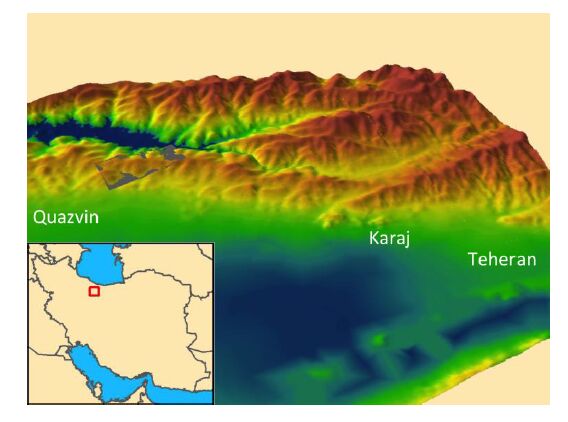
 DownLoad:
DownLoad: 